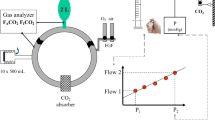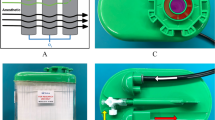Abstract
Low flow anesthesia increases the use of CO2 absorbents, but independent data that compare canister life of the newest CO2 absorbents are scarce. Seven different pre-packed CO2 canisters were tested in vitro: Amsorb Plus, Spherasorb, LoFloSorb, Medisorb, Medisorb EF, LithoLyme, and SpiraLith. CO2 (160 mL min−1) flowed into the tip of a 2 L breathing bag that was ventilated with a tidal volume of 500 mL, a respiratory rate of 10/min, and an I:E ratio of 1:1 using the controlled mechanical ventilation mode of the Aisys® (GE, Madison, WI, USA). In part I, canister life of each brand (all of the same lot) was tested with 12 different fresh gas flows (FGF) ranging from 0.25 to 4 L min−1. In part II, canister life of six canisters each of two different lots of each brand were tested with a 350 mL min−1 FGF. Canister life is presented as “FCU”, fractional canister usage, the fraction of a canister used per hour, and is defined for the inspired CO2 concentration (FICO2) that denotes exhaustion. In part III, canister life per 100 g fresh granule content was calculated. FCU decreased linearly with increasing FGF. The relative position of the FCU–FGF curves of the different brands depends on the FICO2 threshold because the exhaustion rate (the rate of rise once FICO2 starts to increase) differs among the brands. Intra-lot variability was 18 % or less. The different prepacks can be ranked according their efficiency (least to most efficient) as follows: Amsorb Plus = Medisorb EF < LoFloSorb < Medisorb = Spherasorb = LithoLyme < SpiraLith (all for an FICO2 threshold = 0.5 %). Canister life per 100 g fresh granule content is almost twice as long when LiOH is used as the primary absorbent. The most important factors that determine canister life of prepacks in a circle breathing system are the chemical composition of the canister, the absolute amount of absorbent present in the canister, and the FICO2 replacement threshold. The use of the fractional canister usage allows cost comparisons among different prepacks. Results should not be extrapolated to prepacks that fit onto other anesthesia machines.




Similar content being viewed by others
References
Higuchi H, Adachi Y, Arimura S, Kanno M, Satoh T. The carbon dioxide absorption capacity of Amsorb is half that of soda lime. Anesth Analg. 2001;93:221–5.
Dorsch JA, Dorsch SE. Understanding Anesthesia Equipment. 5th ed. Philadelphia: Lippincott Williams & Wilkins; 2007. p. 108–10.
Robinson GJI, Peyton PJ, Terry D, Malekzadeh S, Thompson B. Continuous measurement of gas uptake and elimination in anesthetized patients using an extractable marker gas. J Appl Physiol. 1985;97:960–6.
Stuart-Andrews C, Peyton P, Humphries C, Robinson G, Lithgow B. Continuous measurement of multiple inert and respiratory gas exchange in an anaesthetic breathing system by continuous indirect calorimetry. J Clin Monit Comput. 2009;23:41–9.
Blobner M, Felber AR, Gögler S, Feussner H, Weigl EM, Jelen G, Jelen-Esselborn S. The resorption of carbon dioxide from the pneumoperitoneum in laparoscopic cholecystectomy. Anaesthesist. 1993;42:288–94.
Kazama TI, Ikeda K, Sanjo Y. Comparative carbon dioxide output through injured and noninjured peritoneum during laparoscopic procedures. J Clin Monit Comput. 1998;14:171–6.
Tan PLI, Lee TL, Tweed WA. Carbon dioxide absorption and gas exchange during pelvic laparoscopy. Can J Anaesth. 1992;39:677–8.
Hirabayashi GI, Uchino H, Nakajima T, Ogihara Y, Ishii N. Effects of temperature gradient reduction in three different carbon dioxide absorbents. Eur J Anaesthesiol. 2009;26:469–74.
Harper M, Eger EI 2nd. A comparison of the efficiency of three anesthesia circle systems. Anesth Analg. 1976;55:724–9.
Acknowledgments
The study has not been funded. Jan Hendrickx has received lecture support, travel reimbursements, equipment loans, consulting fees and/or meeting organizational support from a number of companies involved with inhaled agent delivery (alphabetically): AbbVie, Acertys, Air Liquide, Allied Healthcare, Armstrong Medical, Baxter, Draeger, GE, Hospithera, Heinen und Lowensein, Intersurgical, Maquet, MDMS, MEDEC, Micropore, Molecular, NWS, Philips, Quantum Medical.
Conflict of interest
The authors declare that they have no conflict of interest.
Author information
Authors and Affiliations
Corresponding author
Rights and permissions
About this article
Cite this article
Hendrickx, J.F.A., De Ridder, S.P.A.J., Dehouwer, A. et al. In vitro performance of prefilled CO2 absorbers with the Aisys® . J Clin Monit Comput 30, 193–202 (2016). https://doi.org/10.1007/s10877-015-9699-2
Received:
Accepted:
Published:
Issue Date:
DOI: https://doi.org/10.1007/s10877-015-9699-2




